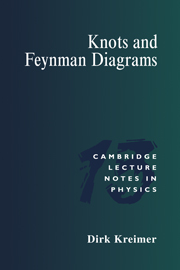Book contents
- Frontmatter
- Contents
- Acknowledgements
- 1 Introduction
- 2 Perturbative quantum field theory
- 3 The Hopf algebra structure of renormalization
- 4 Rationality: no knots, no transcendentals
- 5 The simplest link diagrams
- 6 Necessary topics from knot theory
- 7 Knots to numbers: (2, 2n – 3) torus knots and ζ(2n – 3)
- 8 One-loop words
- 9 Euler–Zagier sums
- 10 Knots and transcendentals
- 11 The four-term relation
- 12 Hopf algebras, non-commutative geometry, and what else?
- References
- Index
4 - Rationality: no knots, no transcendentals
Published online by Cambridge University Press: 04 August 2010
- Frontmatter
- Contents
- Acknowledgements
- 1 Introduction
- 2 Perturbative quantum field theory
- 3 The Hopf algebra structure of renormalization
- 4 Rationality: no knots, no transcendentals
- 5 The simplest link diagrams
- 6 Necessary topics from knot theory
- 7 Knots to numbers: (2, 2n – 3) torus knots and ζ(2n – 3)
- 8 One-loop words
- 9 Euler–Zagier sums
- 10 Knots and transcendentals
- 11 The four-term relation
- 12 Hopf algebras, non-commutative geometry, and what else?
- References
- Index
Summary
This chapter deals with the simplest type of iPWs one could think of. It considers the simplest letters only, one-loop diagrams, and combines them in strictly nested configurations. There will be no disjoint subdivergences.
We note that an iPW which is not primitive necessarily has at least one nested subdivergence, and thus regard the strictly nested configuration as the most elementary one. Note that for strictly nested divergences built on one-loop graphs we obtain words w for which the depth d(w), the order n(w) and the length l(w) agree, and that this is so only for this type of iPW.
The Feynman diagrams generated in this way are known as ladder diagrams, for a reason which is obvious when we look at their realization. We obtain them by restricting the kernel K in the Schwinger–Dyson equation for the vertex function to its lowest order, as demonstrated in Fig. 4.1, so that the contributing vertex corrections are of the form Г[1, 1,…]. This topological simplicity, we claim, is matched by a number-theoretic property of the corresponding Laurent series generated from the counterterms: in the special topologies considered here, these Laurent series have rational coefficients. It is a property which appears as a conspiracy of all the terms contributing to the overall divergence: any single contribution, from the graph and its various counterterms which remove the subdivergences, is highly non-rational.
But for ladder and rainbow diagrams, these non-rational numbers drop out in the combination of terms demanded by renormalization theory.
- Type
- Chapter
- Information
- Knots and Feynman Diagrams , pp. 97 - 105Publisher: Cambridge University PressPrint publication year: 2000



